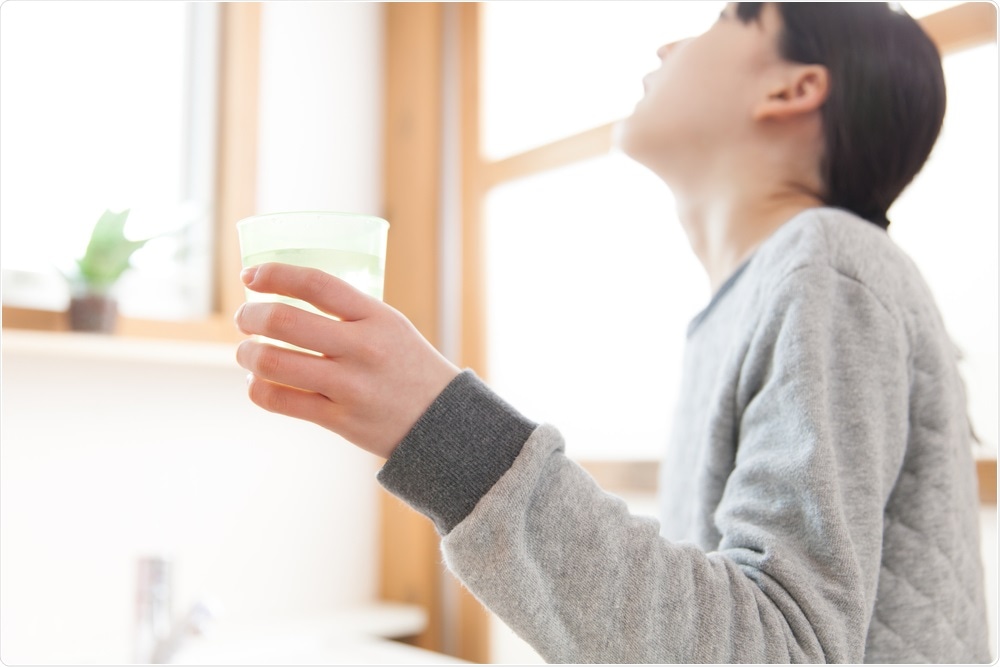Researchers from Chang Gung University College of Medicine, Taiwan, have suggested that throat gargling may have beneficial effects during the coronavirus disease 2019 (COVID-19) pandemic.
Although gargling would not eradicate severe acute respiratory syndrome coronavirus 2 (SARS-CoV-2), it might reduce viral load in the throat and positively influence the course of the disease, say researchers Chialing Tsai and Pei-Chang Wu.
In a letter to the editor published in the journal Public Health, the researchers suggest that gargling with saline or tap water may be beneficial to both high-risk individuals such as healthcare workers and the population in general.

Image Credit: Alexander Knyazhinsky / Shutterstock
SARS-CoV-2 is initially most active in the throat
The team’s suggestion is supported by recent studies showing that the virus is most active in the throat during the early days of SARS-CoV-2 infection. Research has also suggested that gargling with tap water or hypertonic saline can reduce viral load and disease severity in cases of upper respiratory tract infections (URTIs).
Researchers in Hong Kong recently showed that among SARS-CoV-2 patients, viral loads were highest in oropharyngeal swabs taken during the first week of infection, with loads peaking on day four.
Researchers in Germany found that SARS-CoV-2 infection could be diagnosed using throat swabs taken on the first day of symptom onset when illness would typically be mild. During the initial week of infection, viral replication was highest in the throat, while no evidence of infection was identified in feces samples. Furthermore, genome sequencing identified that SARS-CoV-2 present in the throat differed from the virus present in the lung of the same patient.
“Therefore, SARS-CoV-2 is suggested to exhibit tropism for the tissues of the throat,” says the team.
Another study of SARS-CoV-2 conducted in China showed that a higher viral load in the nasopharynx was associated with more severe disease.
Learning from the 2002 to 2004 SARS outbreak
During Taiwan’s experience of the 2002 to 2004 SARS-CoV-1 outbreak, the importance of wearing masks to reduce inhalation of the virus and initial viral load was realized.
During the current pandemic, Taiwan, therefore, introduced the mask-wearing policy early on, which Tsai and Wu say reduced the incidence of COVID-19. However, in some countries where masks have been in short supply, incidence, and mortality rates have been high, they add.
The researchers think that although the main protective measures taken during the current pandemic are still mask-wearing, frequent hand washing and social distancing, new preventative measures are urgently needed to reduce the incidence or at least the severity of COVID-19.
“Reducing the amount of virus in the body tissue at the initial stage of infection might positively influence the course of the disease,” they write. “Thus, throat gargling, an ancient therapeutic method, might be potentially useful in controlling the COVID-19 pandemic.”
Studies supporting the hypothesis
A trial conducted in Japan found that gargling with tap water three times per day reduced the incidence of UTRIs by 36%.
Another trial in England found that, among UTRI patients, nasal cavity irrigation and gargling with a saline hypertonic solution during the first two days of symptom onset was associated with a significantly lower viral load, a two-day reduction in length of illness, a 36% reduction in the use of medication and a 35% reduction in household transmission.
The authors say potential mechanisms underlying the observed benefits of gargling may involve viral shedding and inactivation of the virus. They also think the concentration of chlorine in Japanese tap water is enough to inactivate viruses.
“Chloride ions in hypertonic saline have been shown to inhibit virus replication and are used by cells to produce hypochlorous acid to exert antiviral effects,” writes the team.
Other researchers agree
Writing in the journal Function, another research team says: “It is becoming increasingly recognized that the throat is a major site of replication and shedding of virus in COVID-19 illness and that viral load is important. Throat and sputum are abundant in particles, which peak 5–6 days after symptom onset, and decline thereafter.”
Commenting on the trial in Japan, “it was speculated that chlorine in the water might have contributed, since levels in Japan were above concentrations that are known to have viricidal activity,” write Valerie O’Donnell (Systems Immunity Research Institute, Cardiff) and colleagues.
An effective and “virtually cost-free” way for everyone to benefit
Tsai and Wu point out that since gargling with tap water or saline is almost cost-free, the relative social and economic benefit in terms of reducing URTIs could be huge.
During the current pandemic, “throat gargling habits with tap water or saline might be suggested for high-risk populations of quarantined people and medical staff,” write the researchers.
Furthermore, gargling might also benefit the population overall, they conclude.